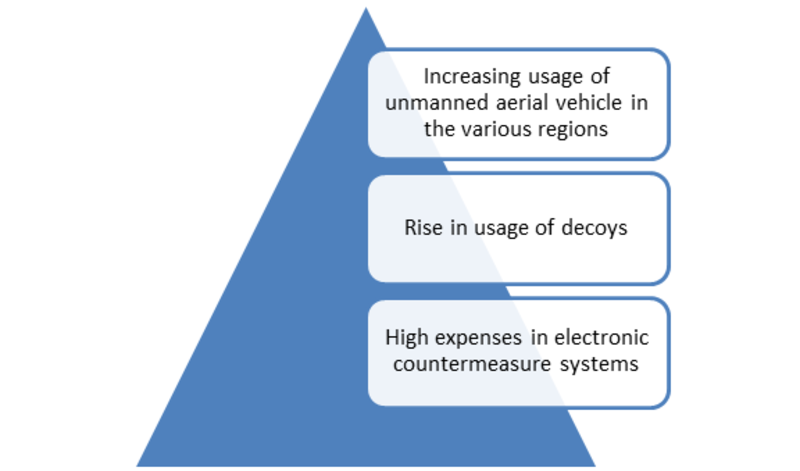Military Jammer Market Outlook
Military Jammer Market Size is anticipated to reach USD 9.8 billion by 2030, registering a CAGR of 7.80% during 2022-2030.
The Military Jammer market has advanced in radio technology from analog to digital, and nowadays, it is involved in the development of wideband radios, which is a new generation of jammer. In a military environment, jammers are frequently located in aircraft, helicopters, or unmanned aerial vehicles as the line-of-sight transmission which helps them to transfer military through communication transmitters located on the ground.
Most digital communications systems need a synchronization military to be transmitted between the communicating devices. Jamming can be concentrated on the synchronization military which will nullify the effectiveness of the entire transmission system. Synchronized systems are very susceptible to jamming. Once the synchronization is lost, the jammer stops its transmission and jammer can only be restart after resynchronization is achieved. Although, it is usually very difficult for the jamming system to know when the synchronization is lost and hence difficult to restart the jammer. Typical jamming transmission is band-limited noise that is barrage jamming. The objective is to inject an interference military into the communications frequency so that the actual military is completely submerged by the interference. Depending on the transmission, some other waveform might be more effective. Waveforms useful for jamming include noise-modulated FM, noise bursts, CW tones (spot jamming), and swept military (swept-spot jamming).
Electronic warfare equipment is progressing in its functionality due to the progression in algorithms and underlying software that impart operational capabilities to the electronic warfare systems. Researchers at the Georgia Tech Research Institute (GTRI) have developed an improved RF jamming technology, where the jammer uses Digital Radio Frequency Memory (DRFM) and has an open and simple construction. The project is termed as Angry Kitten, and it aims to develop an improved adaptability jammer.
North America region mainly drives the global military jammer market. Presence of major vendors and the introduction of favorable government policies in this region is propelling the market growth in North America region. Rapidly growing expenses in military system are predicted to fasten the demand for the military jammer. Thus expected to drive the military jammer market swiftly. This region is expected to maintain its dominance in the market during the forecast period due to the presence of a huge number of military jammer manufacturers in countries like the U.S.
The high governmental support to use the military jammer in military application acts as a key driver for the growth of the military jammer market in the sector. The U.K uses drone jammer technology, which helps track the UAV flown by terrorists. Likewise, the Russian government has taken initiatives to upgrade the helicopter fleet, and the U.S. government has given contract award to Lockheed Martin for the testing and development of long-range radar. Such government initiatives play a major role in the growth of military jammer market over the forecast period.
Drivers:

Key Players
The key players in military jammer market are BAE Systems (U.K), Lockheed Martin Corporation (U.S.), Northrop Grumman (U.S.), Raytheon Company (U.S), Thales Group (France), Saab AB (Sweden), Israel Aerospace Industries Ltd.(Israel), L-3 Technologies Inc. (U.S.), Ultra Electronics Inc. (U.K), and Mercury Systems, Inc. (U.S.).
Scope of the Report
This study provides an overview of the global military jammer market, tracking three market segments across four geographic regions. The report studies key players, providing a five-year annual trend analysis that highlights market size, volume and share for North America, Europe, Asia Pacific (APAC), and Rest of the World (ROW). The report also provides a forecast, focusing on the market opportunities for the next five years for each region. The scope of the study segments the global military jammer market by its radar type, application, frequency band, and region.
- By Type
- Radar Jamming
- Mechanical Jamming
- Chaffs
- Decoys
- Corner reflectors
- Others
- Electronic Jamming
- Spot
- Sweep
- Barrage
- DRFM
- Pulse
- Others
- Inadvertent
- Mechanical Jamming
- Communication Jamming
- By Deployment Type
- Ground-based
- Naval
- Airborne
- By Application
- Counter-IED
- Bomb Disposal
- Military Convoy Protection
- Anti-Riot & Law Enforcement
- By Regions
- America
- Europe
- Asia Pacific
- Middle East and Africa
- South America
Leading companies partner with us for data-driven Insights
Kindly complete the form below to receive a free sample of this Report
| Companies Covered | 15 |
| Pages | 100 |
Certified Global Research Member


Why Choose Market Research Future?
- Vigorous research methodologies for specific market.
- Knowledge partners across the globe
- Large network of partner consultants.
- Ever-increasing/ Escalating data base with quarterly monitoring of various markets
- Trusted by fortune 500 companies/startups/ universities/organizations
- Large database of 5000+ markets reports.
- Effective and prompt pre- and post-sales support.
Tailored for You
- Dedicated Research on any specifics segment or region.
- Focused Research on specific players in the market.
- Custom Report based only on your requirements.
- Flexibility to add or subtract any chapter in the study.
- Historic data from 2014 and forecasts outlook till 2040.
- Flexibility of providing data/insights in formats (PDF, PPT, Excel).
- Provide cross segmentation in applicable scenario/markets.







